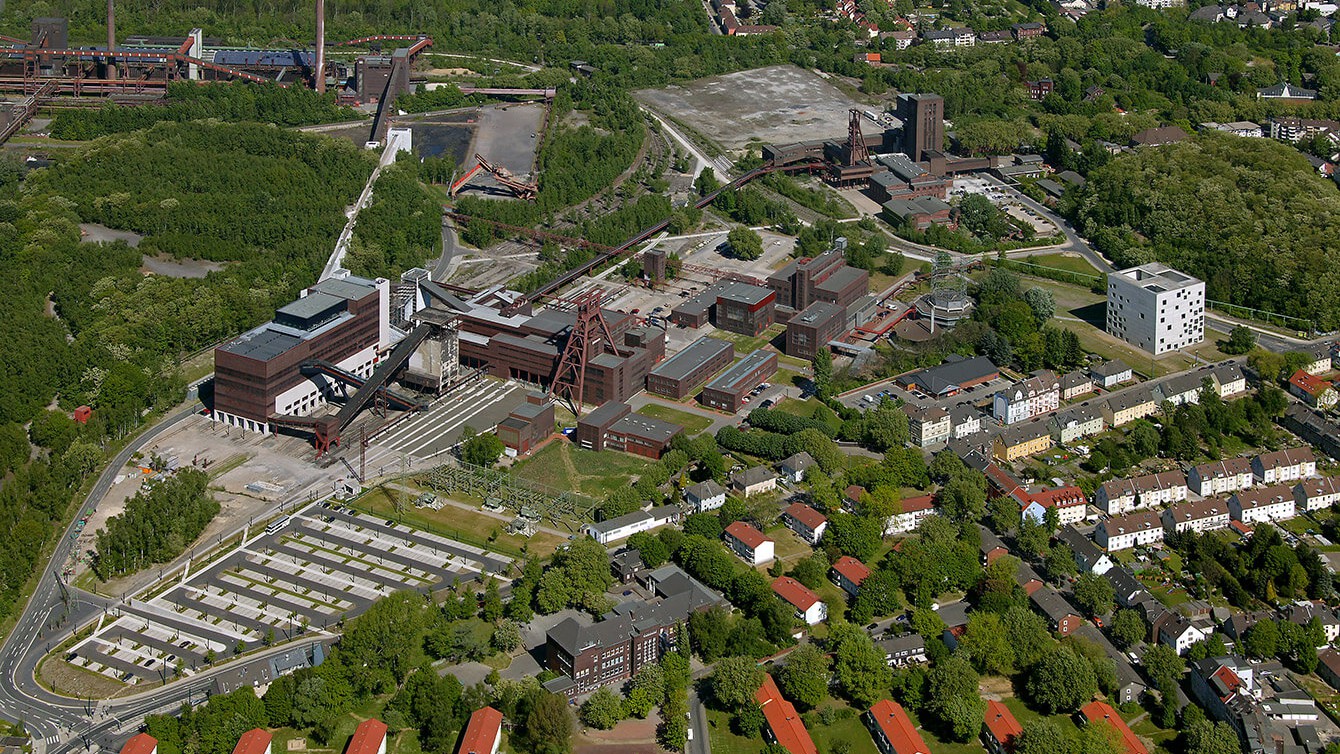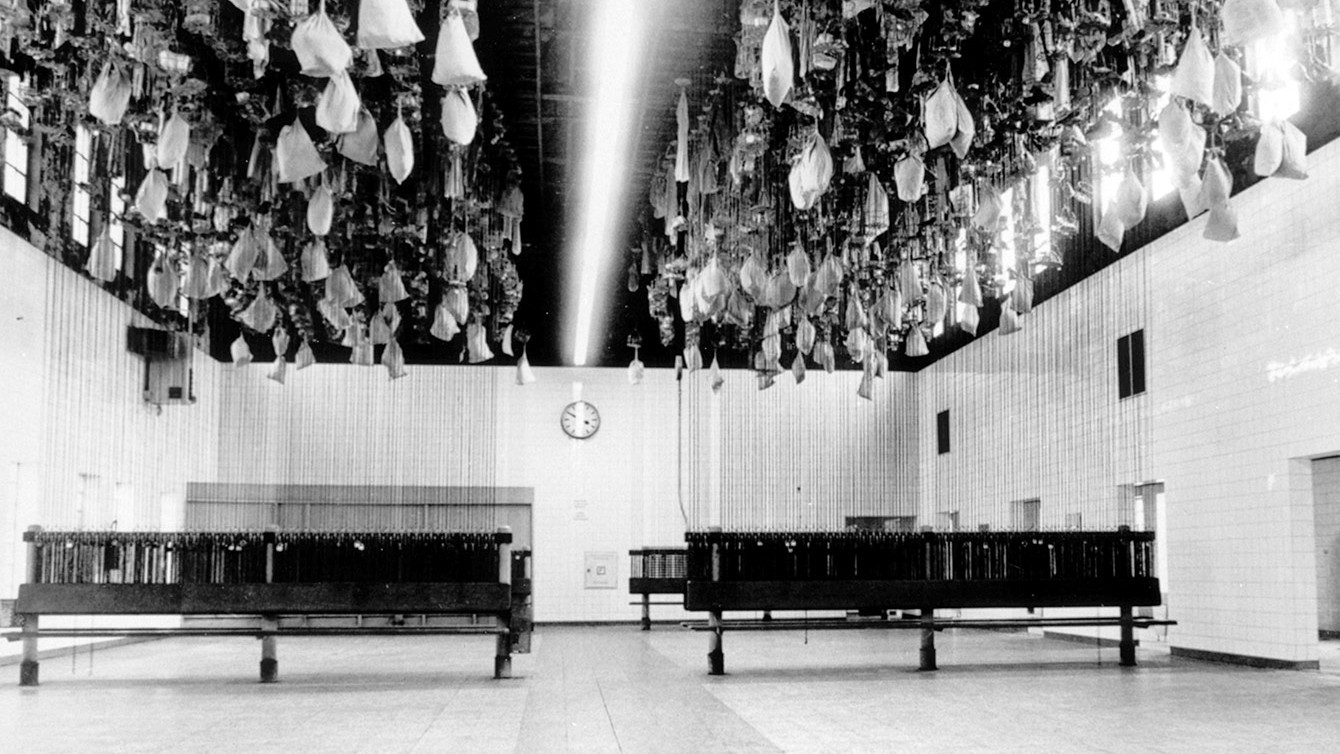Background
The Colliery Zollverein

Foundation
Zollverein XII is the largest preserved colliery in the Ruhrgebiet and as such embraces the whole world of mining work, production and life. The name, meaning Duty Association, was given by its founder Franz Haniel as a reminder of how the Prussians' formed of a commercial association of 18 states into a single duties and trading block in 1834.
Situation
The former colliery of Zollverein is situated in the north of Essen and extends through the city districts of Katernberg, Stoppenberg and Schonnebeck. The construction of the colliery led to a population explosion and a profound transformation of the previous village structure. For the workers and their families, who came mainly from East Prussia, Pomerania, Mecklenburg and Silesia, settlements were founded in the immediate vicinity of the pits. Built or financed by the colliery, they had access to kindergartens, schools, hospitals, churches, cemeteries and a number of consumer facilities. The typical miners' houses still dictate the streetscape and the atmosphere to this day.
Shaft 1/2/8
The location of the first shaft was determined by the Cologne to Minden railway line that opened in 1847, and by advantageous geological factors. Coal mining began in 1851 with Shaft 1/2/8, and around 30 years later this was the site for the complete processing, coking and loading of the coal. With the building of the Kaue in 1907, Shaft 1/2/8 became the focus and pivot of everyone who worked 'down below' at Zollverein.
Shaft XII
Today the mine comprises five individual shaft systems with a total of 12 shafts. Shaft 12 was planned and built in order to lift and process, centrally and fully mechanically, the coal from the other four Zollverein shaft systems.
Fritz Schupp (1896 - 1974) and Martin Kremmer (1894 - 1945) were assigned the task of designing the numerous technical facilities of a large-scale colliery aesthetically, functionally, economically and quickly, but also with the necessary flexibility to cope with possible ground movements and with any changes that operations might necessitate. The result of the building phase between 1928 and 1932 is an all-round design concept whose form draws decidedly from the architectural vocabulary of the Bauhaus school.
With the completion of Shaft 12, Zollverein became the most modern mine in Europe at the time and the largest pit in the Ruhrgebiet. It was able to produce around 12,000 metric tonnes of useable coal per day, four times the normal average output.
On 23 December 1986, with all the mineable coal reserves used up, the miners went to work at the Zollverein colliery for the last time. It had been Essen's last surviving active pit. Instead of demolishing Zollverein, the North Rhine-Westphalian authorities decided to buy it up, declare it a listed building and to renovate it throughout. This project was completed in 1999.
World cultural heritage
On 14 December 2001 the Zollverein colliery and coking plant were included in UNESCO's coveted world cultural heritage list.
Masterplan
21.02.02: Rotterdam architect and town planner Rem Koolhaas ('Office for Metropolitan Architecture'/OMA) presented his concept for the further development of the entire grounds of the Zollverein colliery. The master plan centres around the development of an integrated design and cultural venue.
Background
The Kaue

The Kaue is, to be precise, a changing room with shower facilities at a colliery. In the 'White Kaue' the miners would change from their normal clothes, and in the 'Black Kaue' from their work clothes, and place them in baskets which they would hoist on pulleys up toward the ceiling.
The installation of workers' showers was ordered in the Ruhrgebiet area in spite of widespread moral reservations. They were the mining authorities' hygienic reply to the infection-rife communal baths in which the water was only changed once a day.
1907 Completion of the wash Kaue at Shaft 1/2/8. The shower room was designed for 3,000 miners - an enormous washing facility with an overhead rig where the miners' clothing was kept.
1964 Modernisation
1986 Coal mining comes to an end.
At the beginning of the 1990s the region's choreographers discovered the Kaue as a venue for dance. In the years that followed they worked towards establishing the building as a centre for contemporary dance at Zollverein.
1999-2000 The Wash Kaue was converted into the Choreographisches Zentrum NRW (North Rhine-Westphalia Choreographic Centre) by the Frankfurt architectural firm Christoph Mäckler. The aim was "to retain the original substance with only minimal alterations."
Juli 2000 The centre opened in July 2000 and the programme began with productions, guest performances, advanced training and development initiatives and the first "international dance exchange ruhr" project.
Februar 2002 Fusion to form PACT (Performing Arts Choreographisches Zentrum NRW Tanzlandschaft Ruhr)